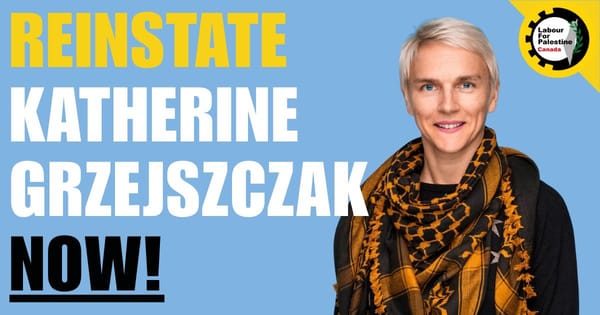When high inflation first set in several months ago, some commentators speculated that we were likely to see increased labour unrest in response. With falling real wages, it was only a matter of time before the organized working class pushed back at the bargaining table and, perhaps, on the picket line, many observers imagined.
While we’ve by no means returned to the militancy of the late 1970s, it does appear that class struggle is on the upswing. As Doug Allan has noted, so far in 2022 days lost to strikes are at a 13-year high in Ontario, and we’re only halfway through the year.
The relatively tight labour market has aided workers in a number of ways. Initially, the wages of non-union workers were quicker to respond to the rising cost of living. Individual workers with new structural bargaining power were able to bid up nominal wages to some degree, though still far short of inflation.
Union members, on the other hand, who were still working under existing collective agreements had to wait for the latter to expire before they could bring their collective wage demands to the bosses. Over the past several months, the uptick in union militancy has been unmistakable.
A strike involving more than 30,000 construction trades workers in Ontario in May put falling real wages in an inflationary environment front and centre. Grocery distribution and other warehouse workers, as well, hit the picket lines and secured respectable wage gains. Mill workers at ArcelorMittal in Quebec managed to win 26 per cent wage increases over six years. The Governor of the Bank of Canada, apparently worried about workers gaining a greater share of surging corporate profits, saw fit to tell employers to stiffen their spines and resist workers’ wage demands.
Thus far, this worker militancy has been highly concentrated in the private sector. As Allan further reports, as of June, 88 per cent of strikes and 99.3 per cent of person days lost to strikes in Ontario were in the private sector. And it’s far from certain that this momentum will taper off soon. Rather, the prospect of additional strikes involving private sector union members remains, with hundreds of collective agreements across the country set to expire in 2022.
The story of public sector union members, on the other hand, was initially somewhat different. Union wage settlements in the public sector thus far this year have lagged behind those in the private sector, despite acute labour shortages in many public services, particularly in health care.
Meanwhile, wage suppression legislation, such as Bill 124 in Ontario, has imposed huge real wage losses on workers in health care, education and other services across multiple jurisdictions.
Although in Canada as a whole, public sector strikes have made up a greater share of work stoppages than in Ontario specifically so far this year — as of July, 53 per cent of strikes (59 of 112) were in the public sector — days lost to strikes across the country remain concentrated in the private sector. So far this year, private sector union members account for 87.4 per cent of strike days. In other words, up to now, strikes of public sector union members have been short and involved relatively few workers.
Things could soon change significantly. In Ontario, British Columbia and the federal public service, unions representing hundreds of thousands of workers are squaring off against governments from across the political spectrum. In some cases, strikes look imminent.
Ontario education workers — teachers as well as support staff — are now in bargaining with Premier Doug Ford’s government and its fiercely anti-union Minister of Education Stephen Lecce, after having served their mandated three years of 1 per cent wage caps under Bill 124. As it stands, bargaining doesn’t appear to be off to a great start.
The union representing support staff has already indicated that it will begin to prepare for a strike vote at membership meetings later this month. Whether plans for a strike vote will be enough to increase the union’s bargaining power at the table remains to be seen. However, the province’s first offer gives every indication that further escalation will be necessary to win decent wage increases for education workers. On August 15, Ontario offered workers making less than $40,000 per year 2 per cent wage increases in each year of a four-year collective agreement, while the remaining workers would receive 1.25 per cent. Hardly the stuff of deal-making when inflation is still running at nearly 8 per cent.
The settlements that emerge from this round of education bargaining in Ontario will be hugely important, setting a standard for other public sector workers in the province and beyond. Workers in health care, particularly nurses, have also been wronged by provincial wage restraint legislation and are fed up with overwork and underpayment. In their case, however, strike action is not an option.
Also in Ontario, union members at GO Transit recently voted 93 per cent in favour of a strike, with the highest voter turnout in the union local’s history. After working under an expired contract since June and bargaining since April, more than 2,200 Amalgamated Transit Union Local 1587 members could soon be on the picket line if no deal is reached with the Crown Corporation Metrolinx.
In British Columbia, while the provincial New Democratic Party government has made some modest reforms to labour law, its approach at the bargaining table with provincial workers has not been much better than Conservatives in other provinces.
The BC General Employees’ Union (BCGEU), representing more than 33,000 workers across provincial public sector workplaces, issued a strike notice on August 12 and commenced job actions on Monday. The BC Public Service Agency, which bargains on the employer side, had been in negotiations with the union since February but continued to table wage offers well below inflation and the union’s proposals. BCGEU members voted 95 per cent in favour of a strike in late June. Meanwhile, the BC Teachers’ Federation and the BC Nurses’ Union have both been working under expired contracts since May and March, respectively.
The Public Service Alliance of Canada (PSAC), meanwhile, declared an impasse in bargaining with the federal Treasury Board in May of this year after the government tabled an offer averaging 1.7 per cent wage increases per year across a four-year contract (2021-2015). PSAC represents more than 120,000 workers across the federal public service. After the union applied for federal mediation, moves were made to establish a Public Interest Commission (PIC) in July to “advance negotiations.” As it stands, members await the PIC’s recommendations before further talks or actions can be taken. According to PSAC, the union will be holding regional events to keep members across the country engaged.
While government employers across Canada try to keep a lid on wage raises and impose the costs of pandemic debt and rising inflation on workers, the growing threat of strike action may cause some employers to reconsider. A rising strike threat — coming not only from workers across the table but from the working class across the country — could change the calculus in contract negotiations.
Now that inflation is beginning to moderate slightly, expect employers — including governments — to claim that temporary inflation will soon be back to “normal” and wage increases to keep up with the cost of living are “unreasonable” and unnecessary.
On the contrary, workers have been expected to absorb the costs of pandemic profiteering and have lost significant ground in the past months of elevated inflation. Wage increases need to make up for that lost ground. The public sector, where the vast majority of union members are concentrated in Canada, could now become the new ground zero in this fight.







